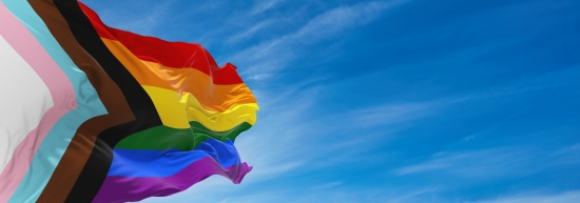LGBT+ in STEM
The RSB is committed to supporting everyone within and through the biosciences.
Celebrating Pride Month
The RSB also marks Pride month by temporarily updating our logo across social media with a tribute to the progress pride flag, designed by Daniel Quasar.
The flag embodies the six stripes of the classic Pride flag and also features chevrons representing the trans, non-binary and LGBT+ BAME communities in recognition of the need for intersectionality across liberation efforts.
You can download our 2022 Pride Month social media cards for use in classrooms, lab spaces or your own online channels.
Barriers faced by the LGBT+ community
The RSB has put together some stats highlighting the barriers the LGBT+ STEM community still faces, as well as a collection of best practice suggestions for organisations and individuals to aid LGBT+ liberation.
- 28% of LGBT+ physical scientists surveyed considered leaving their workplace because of the climate or discrimination towards LGBT+ people, according to a 2019 survey led by the IOP, RSC and RAS.
- Nearly half of trans people surveyed working in the physical sciences considered leaving their workplace because of the climate or discrimination, according to the same survey.
- 49% of LGBT+ physical scientists surveyed agreed there was an overall lack of awareness of LGBT+ issues in the workplace, according to the same survey.
- Just 9% of non-binary physical scientists were out to people at work, compared to 38% of those who identified as lesbian and 44% of those who identified as gay, according to the same survey.
- Transgender, genderqueer, and gender-non-conforming undergraduate and graduate students reported the highest levels of on-campus sexual assault and misconduct, according to the 2015 Association of American University’s Climate Survey on Sexual Assault and Sexual Misconduct.
- A 2014 study found that 69.2% of ‘out’ STEM faculty members felt uncomfortable in their university department.
- LGBT+ STEM professionals are more likely to experience career limitations, harassment, professional devaluation and more frequent health difficulties than their non-LGBT+ peers, according to a 2021 study that surveyed 25,000 STEM professionals.
LGBT+ inclusion best practices
- Tacking bullying and harassment: Developing and implementing safeguarding policies that address bullying and harassment, outlining what is deemed unacceptable and the consequences of inappropriate behaviour, are key.
- The RSB works alongside other organisations such as the Science Council and the Athena Forum, to support the development of an inclusive and supportive working environment.
- Work with the experts: Consider engaging with and supporting organisations and initiatives that are specifically dedicated to LGBT+ community support and celebration. Leading LGBT+ stem organisations include Pride in STEM, LGBT STEM, The STEM village, Trans in STEM, Out in STEM and more.
- Create inclusive strategies and commitments: Publish commitments that state plans to proactively promote equality of opportunity, diversity and inclusion, along with clear targets and time lines where possible. The RSB’s #biosciencesforall initiative can be read online.
- Listen, survey, analyse and learn: Work to create safe environments where LGBT+ people can share their experiences, and help identify potential barriers to inclusion.
- Celebrate your community: Work to create a platform for bioscientists to share their stories and successes, to help actively increase the visibility of the LGBT+ community within STEM. Read more about the impact of the 500 Queer Scientists and an interview with the campaign’s founder in the Biologist.
- Be an outstanding ally: Learn about how to support the LGBT+ community, take up training opportunities when offered, embrace good advice and identification of problems as an opportunity to learn and grow.
- Silence is compliance: A good ally steps up to address insensitivity or negativity, regardless of whether LGBT+ people are present - don’t allow discriminatory behaviour to go unchecked.
- Intersectionality is key: Don’t forget that LGBT+ community is not homogenous and those of different sexualities, genders, races, abilities and backgrounds have different experiences, and good inclusion initiatives should reflect this.
Supporting the trans community within the biosciences
We recognise that there are distinct and different meanings of the words sex and gender.
A helpful set of information can be found via the World Health Organisation.
We support the right of everyone to live their authentic lives, to have their gender identity and expression recognised, and respected.
We promote and encourage kindness and respect in the treatment of others. We also promote wise use of bioscience knowledge and understanding, for benefit now and for a better future.


